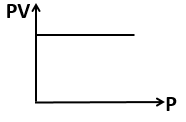In van der Waals' equation of state of the gas, the constant 'b' is a measure of:
1. Intermolecular collisions per unit volume
2. Intermolecular attraction
3. Volume occupied by molecules
4. Intermolecular repulsions
For 1 mole of gas, the average kinetic energy is given as E. The urms of gas is :
1. [2E/M]1/2
2. [3E/M]1/2
3. [2E/3M]1/2
4. [3E/2M]1/2
600 cc of a gas at a pressure of 750 mm is compressed to 500 cc. Taking the temperature to remain constant, the increase in pressure is:
1. 150 mm
2. 250 mm
3. 350 mm
4. 450 mm
The curve that can not represent Boyle's law is -
1.
2.
3.
4.
The deviation of a gas from ideal behavior is expected to be minimum at -
1. 350 K and 3 atm
2. 550 K and 1 atm
3. 250 K and 4 atm
4. 450 K and 2 atm
An ideal gas expands according to PV=constant. On expansion, the temperature of the gas:
1. Will rise.
2. Will drop.
3. Will remain constant.
4. Cannot be determined because the external pressure is not known.
The correct statement for an ideal gas equation is -
1. n is the number of molecules of a gas.
2. V denotes the volume of 1 mole of the gas.
3. n moles of a gas has a volume V.
4. p is the pressure of the gas when only one mole of the gas is present.
The gas among the following that can be most steadily liquefied is -
1. NH3
2. Cl2
3. SO2
4. CO2
Internal energy and pressure of a gas per unit volume are related as
1. p= E
2. p = E
3. p=E
4. p = 2E
If a gas expands at constant temperature, it indicates that
1. kinetic energy of molecules decreases
2. pressure of the gas increases
3. kinetic energy of molecules remains the same
4. number of the molecules of gas increases










